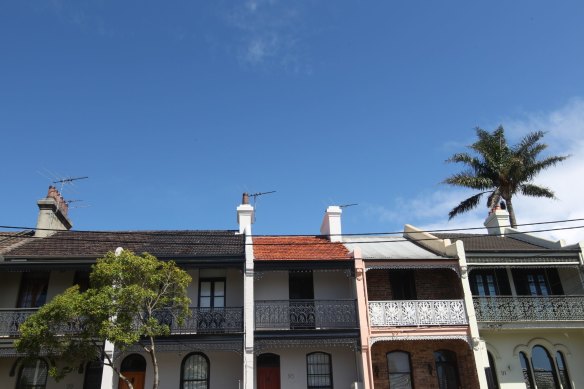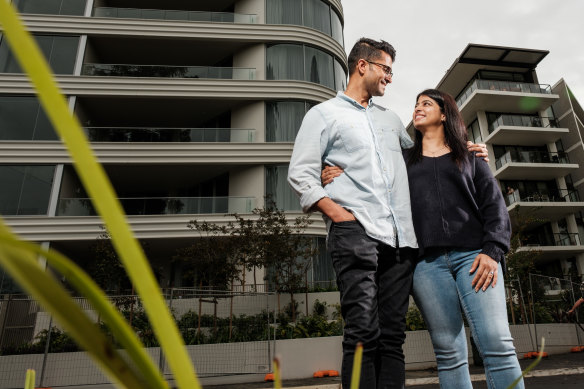This was published 2 years ago
Sydney upsizers face record gap between unit and house prices
By Kate Burke
Making the leap into a larger home has become increasingly difficult for Sydney upsizers, who need to bridge a record price gap to trade up from a unit to a house.
Sydney houses now cost twice as much as units, Domain data shows, with the price difference between the two property types widening rapidly during the pandemic.

Sydney’s median house price is double the median unit price, making it harder for people to upsize.Credit: Peter Braig
More than $794,000 now separates the harbour city’s median house price of almost $1,591,000 and the unit price of about $796,500, climbing from a 54 per cent gap in late 2019 to just shy of 100 per cent last quarter.
Domain chief of research and economics Dr Nicola Powell said demand for houses has soared amid the pandemic as buyers sought more space, with house prices growing six times faster than unit prices over the past two years.
Despite Sydney’s cooling property market – with house price growth flatlining and unit prices down 1.2 per cent last quarter – a record price difference remains.
However, that gap is likely to narrow, Powell said. Unit prices were first to fall, but house prices would follow and could see sharper declines, given their stronger growth during the boom.
Apartment demand could also be propped up by increased investor activity, at the same time as affordability constraints pushed or kept more people in the unit market.
The premium paid for houses varies greatly across the city, with the smallest difference found in more affordable outer suburbs and the Central Coast, and the starkest difference in the city’s east, north shore and inner west.
Median house prices in Vaucluse are more than five times higher than unit prices, while house prices are at least four times higher in Bellevue Hill, Mosman and Strathfield. It’s a virtually impossible gap to bridge for most, though Powell said few apartment owners in such areas would ever expect to be able to upsize locally.
The smallest price gap was in Ingleburn, at just under 10 per cent, or $66,000.
House prices in Riverstone, Quakers Hill, Norwest and Terrigal were also less than 30 per cent above unit prices. Medians were only recorded and compared for suburbs with a minimum of both 50 house and unit sales over the year to March.
Higher price gaps highlighted the extreme cost of land in inner markets, Powell said. While land was more affordable in outer areas, reducing the premium for houses, there were also more low-density apartments and villas on offer. These and newer units could command higher prices, reducing the price difference.
In the inner west, where the house median of $2.4 million is three times the unit median of $800,000, it’s become very difficult to upsize locally, said buyer’s agent Hamada Alameddine of BuyerX.
Apartments had been subject to softer price growth, and owners had built up less equity. More people were leaving the area to upgrade, or opting to upsize to a larger apartment as a result.
“People upgrading from a unit to house are struggling if they’re relying on capital growth. Unless they’re higher earners or have the capacity to borrow a lot more money, it’s hard,” Alameddine said.
While upgraders have a narrower price gap to bridge in more affordable markets, it’s still a sizeable jump, as Norwest couple Dimple and Shamir Kuruvilla recently learnt.
The pair hoped to upgrade from their one-bedroom apartment to a house, but quickly realised their budget fell short, despite both earning a decent wage. The suburb’s median house price sits at $1.4 million, $250,000 above the median unit price.
Mrs Kuruvilla said houses they looked at cost upwards of $1.2 million, and often needed work. Then they also had to factor in stamp duty.

Shamir and Dimple Kuruvilla were hoping to upgrade from their one-bedroom apartment to a house, but opted for a larger unit. Credit: Oscar Colman
“Even if the [price] gap is smaller here, I believe it’s not easy … unless you’re really making a lot of money, for people in an average job it’s really hard,” she said.
Instead of taking on more debt than they were comfortable with, they decided to purchase a new two-bedroom, two-bathroom apartment instead. They hope to be in a better position to upgrade in a few years’ time.
Their selling agent, Maree McCrorie of McGrath Castle Hill, had seen a small increase in people upgrading to larger units rather than houses but noted such apartments were not cheap to begin with and appealed more to downsizers. She expected young Australians would increasingly stay in apartments long term due to affordability constraints but noted convenience was also a factor.
Buyer’s agent Pete Wargent, co-founder of BuyersBuyers, said a lack of suitable stock, strong competition and rapidly rising prices had made upsizing more difficult over the past two years.
Moving from a unit to a house in suburbia was usually the hardest gap to jump, he said.
However, conditions for upsizers would improve with increasing stock levels giving buyers more choice and time. He also expected the higher end of the market, which was traditionally more volatile, to see greater price declines, narrowing the price gap between houses and units.
While the borrowing power of upgraders would be affected by rising interest rates, most upsizers were not borrowing to their maximum capacity, he said. Rate rises would also put downward pressure on property prices.